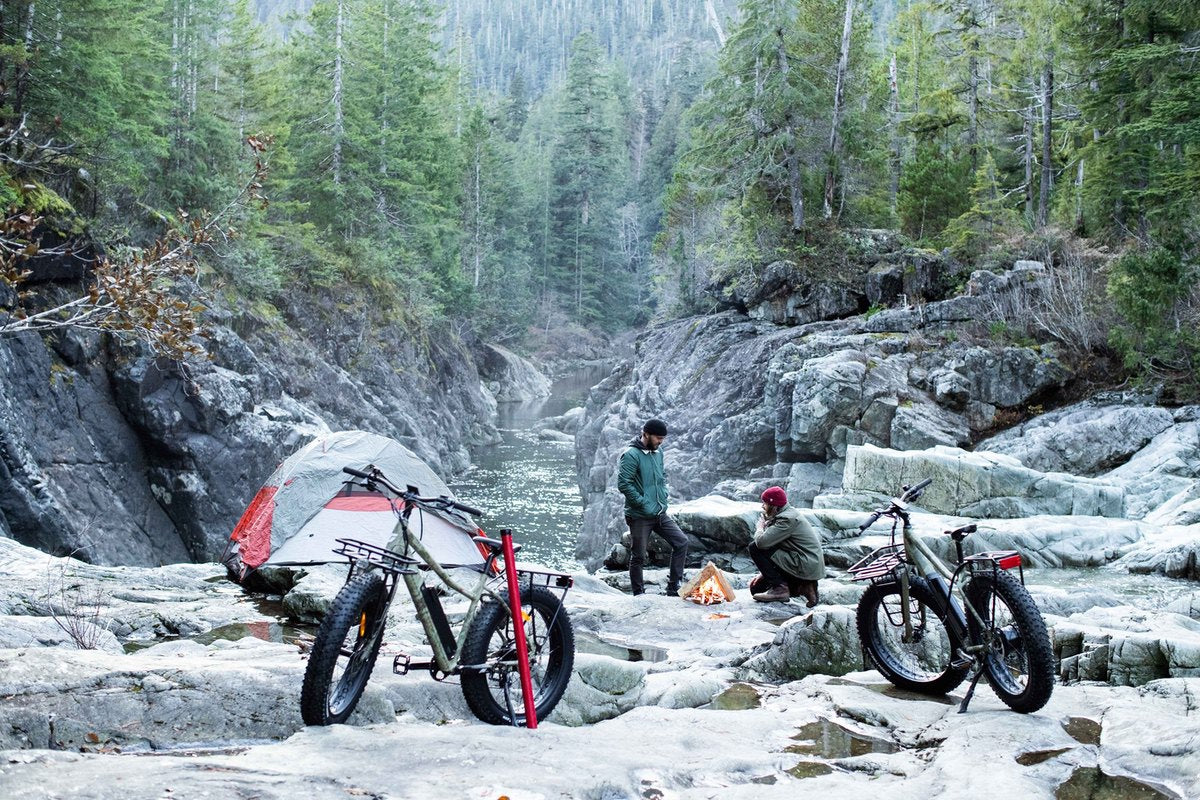The Fat eBike Buyer’s Guide
Summary:
- Fat tire eBikes feature wider tires starting at 4 inches, providing better traction and stability for off-road and challenging terrains like snow, sand, and rocky paths.
- When shopping for a fat tire eBike, essential features to consider include a high-capacity battery of at least 500Wh for extended range, a motor with 500W to 750W power for steep climbs, and durability factors like an aluminum alloy frame.
- Weatherproofing is critical; look for bikes with an IP65 rating, indicating resistance to environmental conditions such as dirt and water.
- Depending on your needs, choose an eBike model with appropriate luggage and accessory options, such as racks or panniers for carrying gear on long trips or outings.
- Surface 604 offers two fat tire eBike models—the heavy-duty Boar Hunter for longer trips and the lightweight Boar Explorer for shorter and faster runs. Both models integrate high-quality off-the-shelf components and include torque sensors to ensure an intuitive riding experience.
Modern electric bikes come in many different styles—but fat tire models are ideal for comfortably cruising over tricky terrain. If you’re looking for a backcountry-ready eBike, you’re in the right place!
Of course, big wheels aren’t the only important feature here—you’ll also need to make sure you buy a fat tire eBike with the right battery, frame design, and luggage for serious use. Below, the Surface 604 team breaks down exactly what defines a fat tire eBike and gives you a checklist of must-haves for your next ride.
What Is a Fat Tire eBike?
Fat tire eBikes are essentially electric bikes that come with extra-wide tires. While standard bike tires typically measure between 1.95 and 2.5 inches in width, fat tires start at around 4 inches. These beefy tires provide better traction, stability, and the ability to traverse more challenging terrain types—like snow, sand, and rocky paths.
How Are Fat Tire eBikes Different from eMTBs?
While fat tire eBikes and eMTBs are both intended for off-roading, they are not the same. Fat tire eBikes are primarily intended to ride comfortably and maintain traction over a wide variety of riding surfaces, while electric mountain bikes are designed to stay responsive while navigating dynamic environments with obstacles and sharp inclines.
The Benefits of Fat Tire eBikes
- Better Grip: The treads and tire thickness you’ll find on fat tire eBikes allows them to retain more traction on surfaces that other bikes would slip on.
- Superior Stability: Since fat tire eBikes have larger contact patches, they tend to stay more planted on (and off) the road, making it easier to stay upright and balanced while riding.
- Adjustable Air Pressure: The tires on fat tire models are designed to operate safely within a wider air pressure range—this means you can essentially adjust the suspension on your eBike to some degree simply by inflating or deflating the tires.
Must-Have Features for Fat Tire eBikes
A truly great fat tire eBike needs more than just rubber—it should also have the comfort and safety features you need for the diverse environments where you plan to ride. Here are a few areas we suggest looking at closely when purchasing a new fat tire electric bike:

Battery Life
Given that fat tire eBikes are often used for long off-road trips, it's essential to consider battery life when you’re shopping for your new model. You need something that can reliably last for days in the wilderness on a single charge, so look for batteries with at least 500Wh of capacity.

Motor Power
Although they aren’t mountain bikes, you’ll likely encounter at least a few steep climbs when you venture out on a fat tire eBike—so you’ll want to buy a model with power to spare. A motor between 500W and 750W is generally considered sufficient.

Durability
Because these bikes are designed for more rugged use, durability is a key concern. Opt for eBikes with high-quality frames made of materials like aluminum alloy.

Weatherproofing
Fat-tire ebikes should be able to ride through rain, sleet, and mud without breaking down or malfunctioning. Look for the IP (Ingress Protection) rating on any bike you’re considering—a two-digit number that reflects a piece of equipment’s ability to withstand different environmental conditions.
The first digit of an IP rating represents the equipment’s resistance to solids, while the second digit indicates its resistance to liquids. The higher the numbers, the more protection you get.
An IP65 rating is considered sufficient for high-quality fat tire eBikes—the “6” illustrates that the bike can resist dirt, sand, and other solid particles, while the “5” shows a reasonable resistance to low-pressure water streams as well.

Luggage & Accessories
Depending on where you plan to ride, you may want to look for a model that comes with panniers or a luggage rack. For instance, if you only want a fat tire eBike for day trips through the foothills, then a lighter and more stripped-down version will be ideal—but if you’re planning to go camping or fishing for days, you’ll need a model designed to carry your gear.
Our Recommended Fat Tire eBikes
Surface 604 offers two fat tire eBikes designed for different applications. These models integrate high-quality off-the-shelf components from trusted manufacturers like Tektro into our proprietary fork and frame designs—resulting in rides that deliver superior performance at an accessible price point.

Boar Hunter
Price: $3699 CAD
Designed for longer trips with heavier loads, this model features front and rear racks to carry equipment and premium Kenda Juggernaut tires to keep you rubber-side-down practically anywhere.
Key Features:
- 4.5” Kenda Juggernaut tires
- 48V 14Ah/672Wh Samsung lithium-ion battery
- 48V 20Ah/960Wh Extended Range Samsung lithium-ion battery available
- 500W (peaks at 750W) Bafang geared hub motor tuned specifically for fat bikes
- Torque sensors for intuitive power delivery
- Durable 6061 aluminium alloy frame
- IP65 rating
- Front and rear luggage racks included

Boar Explorer
Price: $3599 CAD
A lightweight fat-tire eBike intended for more versatility during short-to-medium distance outings, this model is ideal for bombing through the backwoods or down the dunes on day trips. The Explorer saves weight but preserves strength with a brand new proprietary stem made from 3D forged alloy.
Key Features:
- 4.5” Maxxis Colossus EXO tires
- 48V 14Ah/672Wh Samsung lithium-ion battery
- 48V 20Ah/960Wh Extended Range Samsung lithium-ion battery available
- 500W (peaks at 750W) Bafang geared hub motor tuned specifically for fat bikes
- Torque sensors for intuitive power delivery
- 6061 aluminum alloy frame (with Surface 604 3D forged 3.8mm alloy stem)
- IP65 rating
- Rear luggage rack included (optional front rack sold separately)
Choosing Your Fat Tire eBike
While the tires on your fat tire electric bike are certainly important, they’re far from the only features you should consider. Any fat tire eBike you buy should offer enough battery capacity, motor power, durability, and cargo capacity to let you ride their rubber off-road with confidence that you’ll be able to stay comfortable and safe throughout the trip. Ask yourself:
- How long can I ride on a single charge?
- How much power does the motor make and how smoothly is it delivered?
- How strong and stable does the frame feel? How comfortably do I fit on it?
- Will my bike ride safely across streams or in the rain?
- Is there enough space for the gear I want to ride with?
Learn more about our fat tire eBikes by finding a Surface 604 dealer near you and seeing them in person—or see the answers to some of our most common questions about these bikes below. We hope this guide gives you everything you need to buy the off-road ride of your dreams!
Frequently Asked Questions about Fat Tire eBikes
Can I use a fat tire eBike on regular roads?
Absolutely! While they're designed to handle more rugged terrain, the thick tires on these eBikes make for a comfortable ride on regular roads as well.
How do I maintain the fat tires?
Fat tires are generally low-maintenance because their thick rubber is more durable than what’s found on other tire types. However, you’ll want to consult the manual for your new fat tire eBike to make sure you know the appropriate pressure range for your tires, and check it often to make sure it’s in bounds. Tires with too much or not enough air can be more prone to blowouts or make your bike’s handling sluggish and exaggerate wear and tear over time.
Are fat tire eBikes more expensive?
Not necessarily! Off-road bikes generally tend to be more expensive than those designed only for street use, since they come with more advanced safety features and are designed to offer a higher level of performance. But our fat tire electric bikes are priced similarly to our eMTBs, and are more affordable than many other options on the market.
Are fat tire eBikes harder to pedal?
The large tires on these eBikes can require a bit more effort if you’re pedaling without the motor on—but we’ve solved this problem by including torque sensors on the Boar Hunter and Boar explorer models.
Torque sensors adjust the output of the electric motor based on how hard you’re pedaling, so that you never get too much or too little power when pedal assist is turned on. This allows you to keep your ride intuitive instead of either struggling to pedal your bike or relying on the motor entirely.
Can I convert my standard eBike to a fat tire eBike?
Most eBikes are designed to accept tires with specific dimensions. While some conversions are possible, it's usually safer and more practical to purchase an eBike designed with fat tires from the outset.




